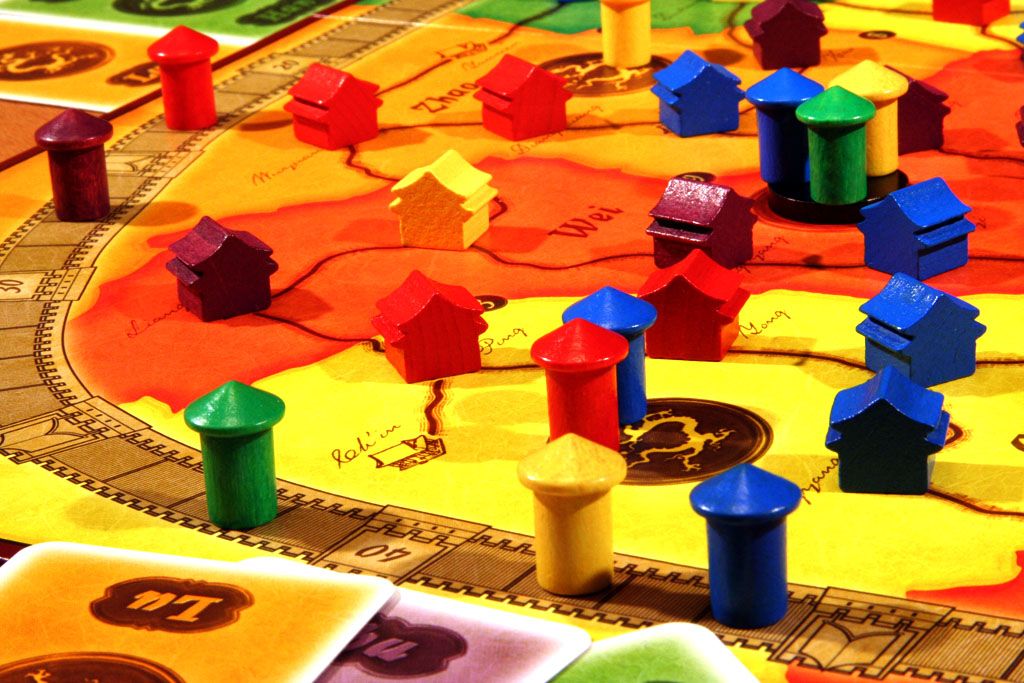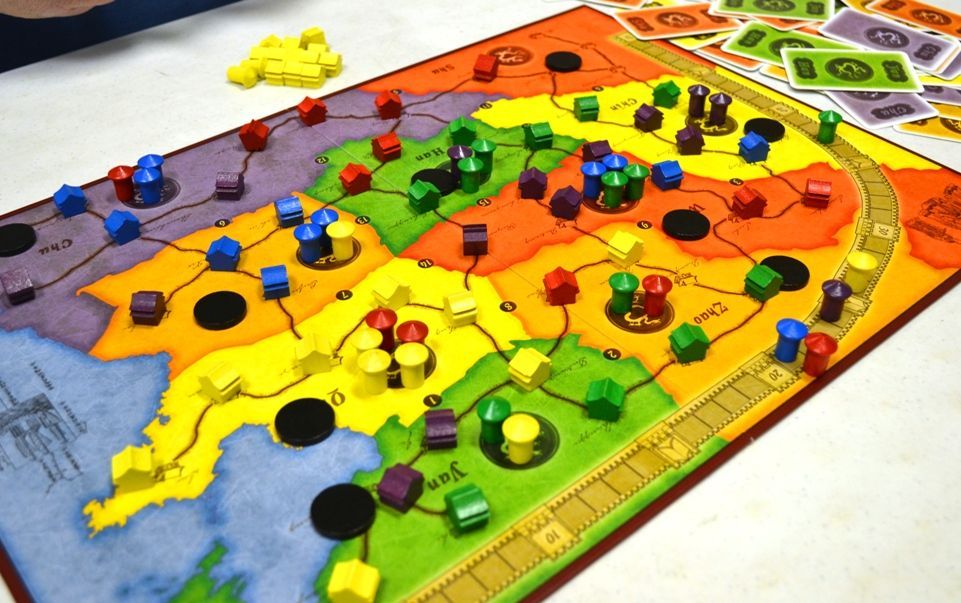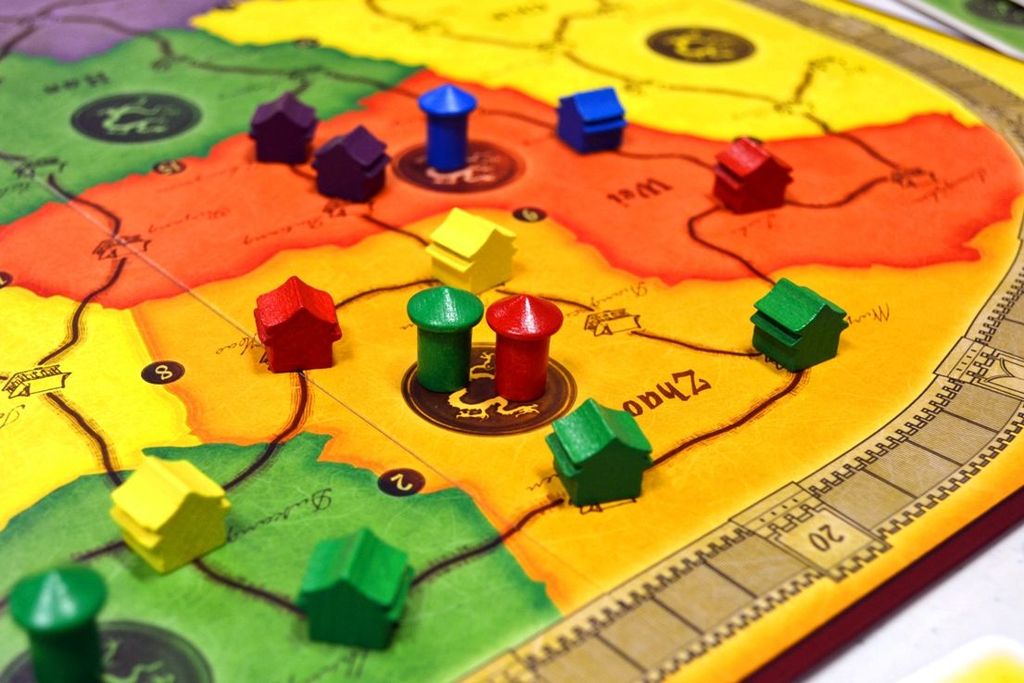Ever found yourself plotting secret alliances, then gleefully blocking your best friend from glory? You’re in the right place. This is my review of a classic area control board game with a bit of an old school twist. I’ve wrangled my friends more times than I can count to play this one, so I know both its wow moments and a couple of its rougher edges. If you hate feeling like a game comes down to just rolling the right number, you might want to keep reading.
How It Plays
Setting Up
Set up China by placing the board in the middle of the table. Each player grabs a batch of colored houses and emissaries. Shuffle and deal cards to each player based on your group size. You’re ready to go when everyone figures out which way is north on the board (hint: it doesn’t matter, but someone always asks).
Gameplay
Take turns playing cards and placing houses or emissaries on matching regions. You can block others or sneak into key cities. The real skill comes from guessing your friends’ sneaky moves and pretending you have a plan. Points come from dominating provinces and major roads. Yes, alliances can form. Yes, someone will break them without blinking.
Winning the Game
When one player runs out of houses, or all regions fill up, it’s time to count points. Add up your provinces, roads, and “my-friend-betrayed-me” moments. The player with the most points claims victory, and everyone else claims they were just testing a new strategy.
Want to know more? Read our extensive strategy guide for China.
How China Keeps the Table Talking: Mechanics and Player Interaction
China is that lovely game where you think you’re building an empire, but in reality, your friends are plotting your downfall right under your nose. I sat down with my usual group of strategic masterminds (and two wildcards who always play with snacks in one hand) to get the full China experience. The main mechanic here is area control. You’re fighting for influence in different provinces by placing houses and emissaries, trying to have the biggest presence. Every move can mess up someone’s plan, so the tension is real. We all squabbled like siblings who’ve just discovered a secret stash of Halloween candy.
Interaction is the meat and potatoes of China. Every action matters, and there’s very little downtime. You’re always on edge, planning your next move while glaring suspiciously at your neighbor. There’s a satisfying amount of blocking: Nothing says friendship like placing a house exactly where Dave needed to go, then watching him groan dramatically. There’s also a neat mechanic where you can win a province by connecting two cities, which leads to plenty of sneaky plays and even sneakier revenge.
What I enjoy most is that you can never just play your own game. You must watch what others do, respond, and sometimes throw a wrench in their plans just because you can. This makes China more about wits than luck – but speaking of luck, let’s march right into the next section where we dig into the epic struggle between strategy and random chance!

Strategy vs. Luck: The Tug of War in China
Let’s get right to the meat: Does China reward clever thinkers, or just those who happen to pick the right card? I’ve played this game enough times to answer with confidence (and a few bruised egos around my table).
In China, strategy is king, queen, and court jester. You have to plan where to place your houses and emissaries, watch your opponents like a hawk, and plot out every move. I once tried to wing it, thinking I’d just ride the wave of luck—big mistake. I ended up spread too thin, outwitted by a friend who built an empire while I was stuck trying to stop him with wild, desperate moves. China makes you plan for the long game. Every choice matters, and if you don’t think ahead, you’ll find yourself steamrolled faster than you can say “dynasty.”
But let’s talk turkey: there’s a smidge of luck. The order in which you draw cards can sometimes mess with your plans. But the thing is, China keeps luck on the leash. Unlike games where dice roll your fate, here luck mostly shuffles your options, not the outcome. If you lose, you can’t really blame the game. (Unless you’re like me and really want to.)
So, if you want a game where thinking beats wishful hoping, China nails it. Sure, you might get an unlucky hand, but smart play almost always wins—something my group loves (except the grumpy sore loser, but we let him pick the snacks).
Next up: Is the art as sharp as the gameplay, or will you wish you brought your own coloring pencils? Let’s talk components and artwork!

China Board Game: Components and Artwork Reviewed
One thing that stands out with China is the feeling you get when you open the box. For a game that’s been around the block, it still looks surprisingly sharp! The board folds out to reveal a map that’s not just functional but also has a bit of charm to it. You get little wooden houses and emissaries (which my friend Dave keeps calling ‘meeple buddies’), and they feel sturdy in your hands. None of those sad, cardboard punchouts that get bent after one game night! I always appreciate a wooden piece — it’s like the board game version of finding a tenner in your coat pocket.
As for the artwork, China nails a vibe that says, “Hey, I’m a classic, but I still look good.” The color palette is gentle and easy on the eyes, with regions standing out just enough to help you plan your moves. The illustrations are simple, but effective. There’s nothing screaming for your attention, and that’s a good thing — you don’t get distracted from gameplay. One of my pals, who’s a graphic designer, said the map layout made him want to move house to one of the painted provinces. High praise, I guess!
The cards and player screens feel pretty solid too, though they’re not the flashiest I’ve ever seen. But hey — no frills means fewer things to drop salsa on (don’t ask). Next up, we’ll see if you’ll want to play China again and again, or if it’s a one-hit wonder!

Replay Value and Fun Factor: How Often Will You Want to Return to China?
When I first cracked open China, I figured it would be one of those games I play once and then shelf. Boy, was I wrong! The replay value here is sneaky-high. Every new session with my friends turns into a wild blend of plotting, alliances, and a lot of fake outrage when someone blocks your final move. If you play with different groups, the game morphs a bit, depending on how cutthroat or chill your crew is. My buddy Derek? Always goes for the sneak win. My mom? Ruthless road-builder. Me? Usually just thankful I don’t mess up the rules.
It helps a lot that the board is double-sided, so you can shake up your strategies as you play more. There’s also plenty of room for experimenting with new plans; sometimes you scheme to control everything, other times you go full chameleon and blend in. This makes China fresh even after a bunch of plays, which is more than I can say for about half my collection (no offense, Monopoly).
Fun factor? Oh, it’s there — especially if you like watching friends squirm as you place that one minister in their way. The game brings out a nice mix of light competition and social bluffing without getting mean. Nobody gets left behind either, so there’s no player elimination nonsense. Everyone’s in until the last round, and the finish feels tight more often than not.
Bottom line: If you enjoy tense area control with a hint of trickery, I highly recommend China. It’s a staple at my table for a reason.
Conclusion
China turned my game night into a tense contest of blocking, bargaining, and the occasional dramatic table groan. Its clever area control and simple rules gave us plenty to chat about—and argue over—long after the final score. Sure, I wish the theme popped more and the art was less ‘medieval wallpaper,’ but the smart play and low luck make up for it. If you want sharp competition and real strategy, China is a solid pick. Thanks for joining my merry band of board gamers for this review—see you at the next board game showdown!


